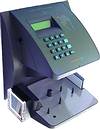
Although the primary function of any biometric device is to verify the identify of an individual, access control requires the ability to identify the person plus unlock a door, grant or deny access based on time restrictions, and monitor door alarms. There is a variety of ways biometrics accomplish this task with presently based card systems.
Biometric manufacturers offer a variety of different methods to integrate biometrics into conventional access control systems. The most common way is 'card reader emulation'. This method is very effective when integrating into existing card-based systems to bring extra security to the front entrance or server room. The wiring is identical to the card reader's wiring.
In this mode, the biometric device essentially works with the access control panel in the exact same way that a card reader does. The card reader output port of the biometric is connected to the panel's card reader port. When a person uses the biometric, it outputs the ID number of the individual if, and only if, they are verified.
The format of the output is consistent with the card technology used by the access control panel. Once an ID number reaches the panel, it is handled as if it came from a card reader. The determination of granting access is made by the panel. The access control panel, not the biometric, handles door control and monitoring.
As an alternative to a keypad, some biometric readers also have a card reader input capability, the most common being proximity and smartcards, although other technologies are also supported. At the biometric unit, the user swipes her card, which contains her ID number. If verified, that card number is sent up to the panel for a decision.
Smartcard systems
Smartcards raise the bar even higher, providing additional capabilities and flexibilities. As costs begin to come down and use is more widespread, biometric devices can leverage their secure data storage. For instance, a single smartcard can store both the user's ID number and biometric template. Because of this, there is no need to distribute hand templates across a network of readers or require the access control system to manage biometric templates. This means integration to any existing access control application is greatly simplified, eliminating extra network infrastructure costs. Because the template only resides on the card, the solution also eases individual privacy concerns.
Providing the best of smartcards and biometrics, the solution provides dual authentication by requesting both the right card and the right person. A smartcard reader is embedded into the biometric reader. A plastic cardholder is affixed to the side of the unit. The verification process takes approximately one second and is virtually foolproof.

For more information contact Bill Spence, IR Recognition Systems, 091 408 341 4100, [email protected]

© Technews Publishing (Pty) Ltd. | All Rights Reserved.